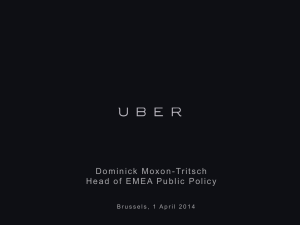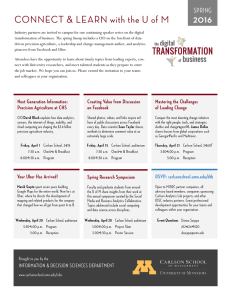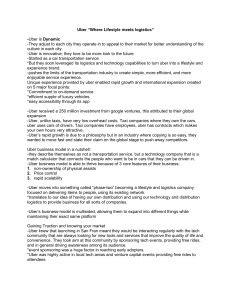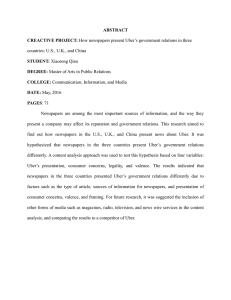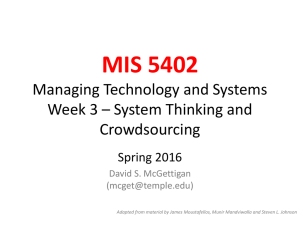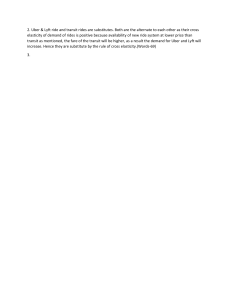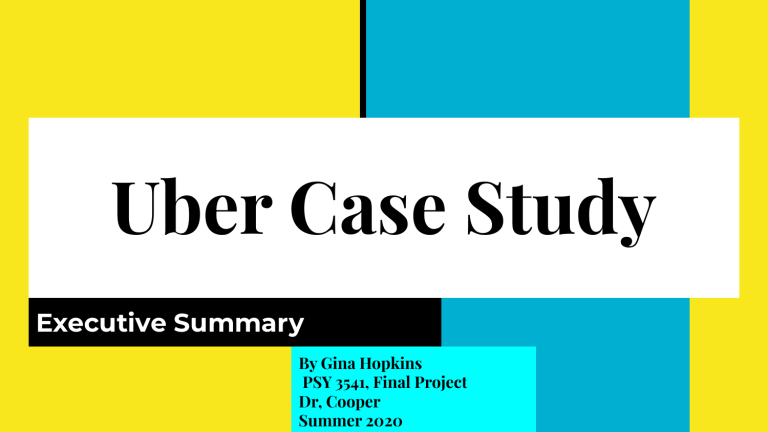
Uber Case Study Executive Summary By Gina Hopkins PSY 3541, Final Project Dr, Cooper Summer 2020 Uber’s Employee vision, value and loyalty ★ Every business may have disgruntled employees and former staff can become “naysayers.” Those ”sour grapes” are not unusual. Yet, recent rumors of reported mistreatment surfaced at Uber in ways nobody expected. ★ Is it possible that “the good old boy’s club” morphed into the start-up environment? As accusations came forward, and Uber executives dismissed the warning signs. Maybe HR didn't take action, or perhaps they looked the other way too often, and perhaps HR was simply too busy to notice the growing tide and manage down to the details. ★ Suddenly, the CEO was caught off guard, and had to take “extended” time off. This sent shock waves across investors, customers, and staff alike. How is Uber Culture, and can it be changed? Uber culture has many things that work against them, such as Lyft competition and dissatisfaction from taxi cab drivers. There are few important questions that this company should focus on: ★ ★ into what tradeoffs the company needs to look to evaluate its values to make its stakeholders happy and its employees more motivated to perform better, as well as how could individual staff, work teams, and the overarching organization as a whole be involved to understand what to do now to improve Uber’s culture and look into its values as a company, ★ at the same time how Uber could successful measure these changes, ★ and finally what would indicate that the intervention in its culture and values had successfully addressed the most important problems needing to be changed to ensure this company’s successful growth ★ What might be a realistic practical business solution involve and entail for Uber? “It started as a simple idea: What if you could request a ride from your phone? But what began as just a thought quickly grew into a global brand focused on helping move you toward opportunity out in the world.” (www.uber.com) Who is Uber: some facts Founders: Travis Kalanick and Garrett Camp. Company Headquarters: San Francisco, California, United States. Funding received by Uber: $22.2 Billion. (as of December 2017). Company Valuation: Over $70 Billion. Number of Users: More than 50 Million. Number of registered drivers: Approximately 7 Million (as of November 2017). Average number of daily Uber Trips in the US: 4 Million (45 rides/second) (Uber’s Executive summary) Uber revenue and usage 80% Uber Rides 15% Uber Eats 5% Uber Freight https://www.businessofa pps.com/data/uber-statist ics/ Working Conditions at Uber ★ Uber has so many good things going; Demand continues, and scandal hasn’t devastated business so far. Despite many allegations about Uber’s safety, they aren’t going out of business anytime soon. ★ But competitors like Lyft are gaining market share and some investors have pulled out. ★ Some customers have even left, boycotting, reporting to friends and family that they can get around just fine (without variable demand pricing). ★ Potential recruits are wary of working at a firm where allegations of mistreatment and abuse characterize the day-to-day environment. ★ Many of the “founding few” are still among the most powerful. But some of them worry that Uber may not be the amazing place to work it once had been heralded, or at least the future and draw has become less brighter. Uber’s strengths and weakneses comparison Favorable Unfavorable Internal Opportunities: employees and stakeholders satisfaction abuse characterize the day-to-day environment. External Strengths: Demand continues Competition gets stronger Going above and beyond to compete and looking more into a company's values, and perhaps looking more into satisfaction of their employees. For example in May 2020, Uber laid off 3500 of Addressing issues posted by this Case Study their employees, about 14% of its workforce, and informed them the same day of this with an announcement through an online Zoom call. Many of their employees were “stunned” with this 1. What tradeoffs Uber needs to be approach. “Potential recruits are wary of working at a firm evaluated? where allegations of mistreatment and abuse characterize the day-to-day environment.” (Case Study) This environment has to improve. The HR department should be more involved in the culture of the company and manage the flood of complaints, instead of the CEO taking time off and worrying the main supporters of the growing company: the investors, customers (stakeholders), Addressing issues posted by this Case Study and employees. “Uber must continue to be relentless to ward off competition, and address growing waves of legislative initiatives by cities and municipalities 2. How might individual staff, work teams, and the overarching organization as a whole be involved to understand what to do now? limiting access.” (New York Times). For future Uber has to change its perspective to show that drivers are Uber’s competitive advantage, and they will have to feel more connected with the company and its new business model, as well as high turnover problem must dissipate. The change of the company’s culture could be measured in two ways, employee Addressing issues posted by this Case Study satisfaction (through surveys), and by researching the company’s current model through the eyes of stakeholders (investors 3. How could successful change be measured? and customers). The one of the most important problems to be addressed was customer safety. Every company should address this sooner than Addressing issues posted by this Case Study later; in Uber’s case, there were too many complains about sexual harassment, and extra cleaning charges from underpaid 4. What might indicate that the intervention had addressed the most important problems needing to be addressed? drivers. Uber’s approach to safety ● ● ● ● In 2018 Uber produced its executive summary: US Safety Report, where they blamed media coverage to cover the sexual harassment at Uber as “as drivers the alleged offenders, our data shows that drivers report assaults at roughly the same rate as riders across the 5 most serious categories of sexual assault. Divers are victims, too”. They also stated in the same report that “The vast majority (99.9%) of Uber trips end without any safety-related issue at all.” They produced their own statistics to prove their point, Despite Uber’s own defense, they invest vastly in the rider’s safety by adding to their app: emergency button, Ridecheck, and Real-time ID check among others. Here are few steps that this company already took to address it: ● When scheduling a ride with Uber using their app, neither driver or rider can see each other's phone numbers. Addressing issues posted by this Case Study ● Once a trip is completed, the Uber’s app also protects rider information by concealing specific pickup and dropoff location information in driver’s trip history. 5. What might a realistic practical business solution involve and entail? ● The rider has also an option to give a pin code to their driver to verify that they are in the right car, They also can check the picture of the driver as The number one priority of Uber should be customer safety. well. The trip won’t officially start until the driver enters the code. This feature is Uber’s response to the murder of student Samantha Josephson. Overall recommendations ★ Uber’s culture included too much focus on aggressive growth and intense competition, and failure to prioritize cooperation compliance with many regulations. ★ Uber should promote more internal transparency that can result in teams that are more coordinated and have more knowledge of internal sharing. ★ Uber should focus more on its employee satisfaction than rigorous competitiveness, and look out more for infractions committed by its top performers. This way the internal and external cultures would change to more friendly. This could be a new definition of being competitive and have positive values at the same time. Bibligraphy Aadmont, Michel, (2016), “Industrial/Organizational Psychology, an Applied Approach”, Cengage Learning, Cengage.com/global Isaac, Mike, (2017), Inside Uber’s Aggressive, Unrestrained Workplace Culture. The New York Times. https://www.nytimes.com/2017/02/22/technology/uber-workplace-culture.h tml Uber (2018), US Safety Report, Executive Summary, https://www.uber-assets.com/image/upload/v1575580685/Documents/Saf ety/UberUSSafetyReport_201718_ExecutiveSummary.pdf
